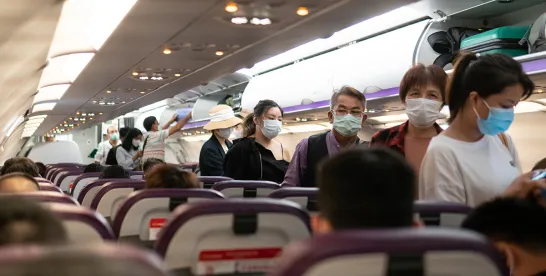On July 6, 2021 the U.S. State Department publicly announced that the travel ban waivers related to the world-wide pandemic will now be good for 1 year and multiple entry. The effective date of this new decision is June 29, 2021. Previously they were only good for 30 days and a single entry. In addition, those that have received a waiver in the past may now use it for 12 months if it was granted after June 29, 2020. See: https://travel.state.gov/content/travel/en/News/visas-news/extension-validity-for-nies-for-china-iran-brazil-south-africa-schengen-uk-ireland-india.html
However, the waiver will only be good for business travel that meets the strict National Interest Exception (NIE) requirements, not for tourism.
The travel bans imposed by the U.S. Government during the COVID-19 national pandemic created enormous logistical challenges for anyone seeking to fly to the U.S. from a country on the travel ban list. Even today, there is still a great deal of confusion regarding who is subject to the travel ban, what are the exceptions, and how to go about applying for a NIE waiver. Our NIE checklist to the U.S. travel bans below is intended to help simplify an albeit complicated process.
Latest Update from the U.S. State Department: June 29, 2021 and publicly announced on July 6, 2021
Countries with Travel Bans: The Schengen area, the United Kingdom, Ireland, China, India, Brazil, South Africa, and Iran.
Schengen Countries include: Austria, Belgium, Czech Republic, Denmark, Estonia, Finland, France, Germany, Greece, Hungary, Iceland, Italy, Latvia, Liechtenstein, Lithuania, Luxembourg, Malta, Netherlands, Norway, Poland, Portugal, Slovakia, Slovenia, Spain, Sweden, and Switzerland.
Transit Through a Banned Country: If one’s flight originated from a safe country and then makes a connection in a travel ban country, then that will trigger the need for an NIE waiver or to spend 14 days in a safe country before entering the U.S. Travelers should seek non-stop flights to the U.S. to avoid stopping in a country on the travel ban list. For example, a flight from Dubai to Los Angeles with even a short stop-over in London will likely trigger the ban.
Family and Other Exemptions: U.S. citizens, lawful permanent residents, certain close family members, and other enumerated visa applicants do not need an NIE waiver at all. See further below for the full list of Exemptions.
14-Day Exemption: There is an exemption for those who spend 14 days outside of one of the “Banned Countries” (i.e. spending 14 days in Mexico or the Caribbean).
NIE Criteria to Prove to the U.S. Embassy: Those who are seeking to provide vital support or executive direction for critical infrastructure or for significant economic activity in the United States. In addition, journalists; students and certain academics covered by the J-1 exchange visitor programs; immigrants; and fiancés may now qualify for an NIE.
Physical Presence in Country at Time of Application: Must be in the country where the NIE will be filed at the time of submitting the NIE request to the U.S. embassy or consulate.
NIE Travel: As of July 6, 2021, good for multiple entries within 365 days of issuance. Previously it was only good for a single entry within 30 days of issuance.
Family members Unlikely to Get an NIE on ESTA: Spouse and children seeking to get a NIE waiver to travel on ESTA are not likely to be approved since the spirit of the rule is to support critical business travel.
Family members Derivative to a Work Visa: Family members that are derivative to the primary applicant who holds a work visa (i.e. H-1B, L-1, E-2, O-1 etc.) should be approved since they also need to travel to live in the U.S. with the principal Their information should be included at the time the principal files the NIE request. In addition, they are strongly encouraged to travel at the same time as the principal applicant to avoid issues at the port of entry, since NIE data regarding the family members may not be in the U.S. Customs and Border Patrol (CBP) system. If they must travel separately, they should carry a copy of the NIE approval e-mail from the U.S. Consulate as well as the original request that was sent to the U.S. Embassy, the principal applicant’s passport ID page, their visa or ESTA, marriage certificate with translation for spouses, and birth certificates with translations for children. Family members cannot use the NIE for tourism. It must be to follow to join the principal applicant who is in the U.S. on critical business.
ESTA Travel: Check the local U.S. Consulate for NIE filing instructions. Make sure your ESTA registration is current. They are valid for 2 years at a time. If your ESTA is expiring, you may apply for a new 2-year period at any time but once you do so it will cancel out your current ESTA registration.
Future Travel on Waiver: The one-year NIE waiver can only be used for the purpose under which it was granted. A NIE waiver for business travel cannot be used for tourism on a subsequent entry.
Need Visa: Need to first ask for an expedited appointment based on an NIE.
Visa Just Issued: The NIE approval should already be endorsed on the visa. Prior to June 29, 2021, the endorsement would show valid for a single entry within 30 days. These are now valid for 1 year regardless. On or after June 29, 2021 the visa should show the NIE waiver is valid for multiple entry for 1 year.
Have Visa But it was Issued More than 30 Days Ago: Based on new guidance, the visa holder can continue to travel on this visa for 1 year since it was approved. The one year of travel is replacing the 30 day, one-time entry.
Visa Stamping in Another Country: If traveling from a Banned Country, a person must wait 10 days in that country before entering a U.S. Consulate for visa stamping. There are limited appointments for third country nationals or nationals not living in the jurisdiction. Many consulates state that they are not issuing visas to third country nationals due to limited visa services being offered. May need to make expedite request if appointment is many months out.
Air Travel from Mexico and Canada to the U.S.: There is currently no travel ban in place, therefore no NIE is required.
Travel from Canada/Mexico via the Ground Border with the U.S.: Only essential travel is allowed – those with work visas, USC’s, LPRs etc. There is no NIE process available.
Passport Expiration: Ensure that your passport is valid for at least 6 months beyond the intended stay, otherwise U.S. Customs and Border Protection (CBP) may deny entry or severely limit the period of stay.
Negative COVID Test: The U.S. Center for Disease Control (CDC) and most airlines require a negative COVID test performed within 72 hours of flying to and from the U.S.
Quarantine Upon Arrival into the U.S.: Check the local requirements in the state, county, and city that you are flying to: quarantine requirements vary from none to up to 14 days depending on local conditions.
Monitoring Expiration Dates: One must be diligent in monitoring all expiration dates including:
-
One year expiration of the NIE
-
Passport expiration
-
ESTA registration expiration or visa expiration registration
-
If entering on a work visa, the petition expiration date (PED).
-
I-94 expiration issued by U.S. Customs and Border Protection at the port of entry
Full List of Family and Other Exemptions from the Travel Ban (NIE not Needed):
○ U.S. citizens (aka USC’s)
○ U.S. nationals
○ Lawful permanent residents of the U.S. (green card holders, or “LPRs”)
○ Spouses of USC’s and LPRs
○ Children of USC’s and LPRs that are single and under the age of 21
○ Siblings under the age of 21 of USC’s and LPRs
○ Parent or legal guardian of a USC or LPR child who is single and under age 21
○ COVID-19 health care workers and researchers
○ Airline and sea crewmembers
○ Ambassadors, diplomats, U.N. workers etc.
○ Journalists
○ Extraordinary humanitarian circumstances
○ National security
○ Public health
○ Support important U.S. law enforcement objectives
○ Students with valid F-1 or M-1 visas traveling to begin or continue an academic program do not need to contact the U.S. Embassy to seek an individual NIE to travel. They may enter the U.S. no earlier than 30 days before the start of their academic program. NIE eligibility for students who have been present in Brazil, China, India, Iran, or South Africa applies only to programs that begin on or after August 1, 2021.
○ Very select J-1 exchange visitors, including au pairs.
○ Anyone spending 14 days outside a Banned Country
NIE REQUEST CHECKLIST
-
Confirm that the country is on the COVID Travel Ban List.
-
Confirm that no exemption applies.
-
Check the local U.S. Embassy or Consulate website for specific filing instructions for the National Interest Exception to the COVID Travel Ban.
-
Some U.S. Embassies require that you make a short request on their portal and will send you a formal questionnaire to include with your NIE filing. Others ask that you e-mail them with all the information at the outset. Other embassies indicate that you must first request an expedited appointment with an NIE justification through the Department of State appointment booking system.
-
E-mail your NIE request to the e-mail address specified for your applicable U.S. Consulate:
-
In the subject line state: CONSIDERATION FOR NATIONAL INTEREST EXCEPTION – LAST NAME.
-
Attach passport ID page of principal applicant.
-
Attach passports of spouse and minor children if they are traveling with the principal. (Note: Some U.S. Consulates are asking that the derivative family members make their own separate request.)
-
Attach the current ESTA registration if seeking to travel on ESTA, or a copy of one’s current visa if already obtained. Same with spouse and children if traveling together with the principal.
-
Attach a signed NIE support letter, usually from a U.S. company, outlining why the proposed travel will provide vital support or executive direction for critical infrastructure or for significant economic activity in the United States.
-
List the following information in the body of the e-mail:
-
Name as it appears on passport
-
Date of birth (XX-MON-XXXX i.e. 01-JAN-1999)
-
Country and city of birth
-
Passport #
-
Passport date of issuance
-
Reason for travel
-
Intended travel date
-
Proposed itinerary
-
A scanned copy of the passport’s biodata page in PDF and right side up.
-
A scanned copy of the valid ESTA or visa in PDF and right side up.
-
Personal E-mail address (one for each individual applicant)
-
Letter from your employer indicating your job title, a brief description of your duties.
-
Critical infrastructure industry of your work.
-
Exact specific activities you intend to perform.
-
How these activities directly support the critical infrastructure.
-
Why these activities require your physical presence in the United States.
-
Why alternatives such as video conferencing, teleworking, or actions by proxy fail to directly support the critical infrastructure.






 />i
/>i

